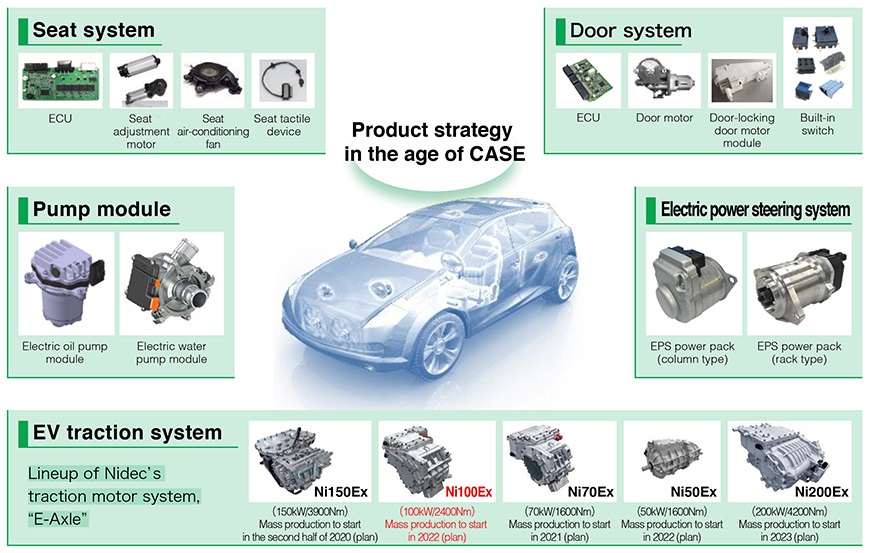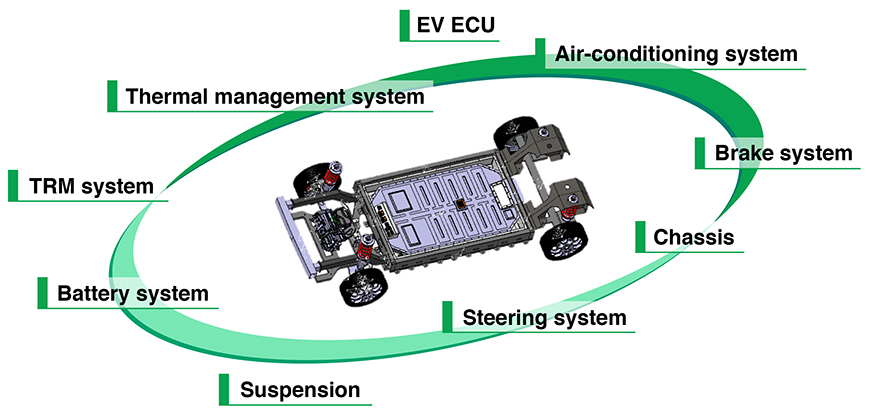About E vehicle
Electric Vehicles
All-electric vehicles—also referred to as battery electric vehicles (BEVs)—plug-in hybrid electric vehicles (PHEVs), and hybrid electric vehicles (HEVs) all use electricity, which improves vehicle efficiency. In colloquial references, these three vehicle types are sometimes called electric cars, electric-drive vehicles, electric vehicles, or simply EVs even though some of these vehicles still use liquid fuels in conjunction with electricity. BEVs and PHEVs are also referred to more specifically as plug-in electric vehicles (PEVs). View a short introductory video for more information on electric vehicle technology.
All-Electric Vehicles
All-electric vehicles, also called battery electric vehicles, have a battery that is charged by plugging the vehicle in to charging equipment. These vehicles always operate in all-electric mode and have typical driving ranges from 150 to 400 miles.
Plug-In Hybrid Electric Vehicles
PHEVs are powered by an internal combustion engine and an electric motor that uses energy stored in a battery. PHEVs can operate in all-electric (or charge-depleting) mode. To enable operation in all-electric mode, PHEVs require a larger battery, which can be plugged in to an electric power source to charge. To support a driver’s typical daily travel needs, most PHEVs can travel between 20 and 40 miles on electricity alone, and then will operate solely on gasoline, similar to a conventional hybrid.
Hybrid Electric Vehicles
HEVs are powered by an internal combustion engine and one or more electric motors that use energy stored in a battery. The vehicle is fueled with gasoline to operate the internal combustion engine, and the battery is charged through regenerative braking, not by plugging in.
Tax Credits and Incentives
Some all-electric and plug-in hybrid vehicles qualify for a $3,700 to $7,500 federal tax credit. Many states also offer additional incentives for purchasing new EVs.
![]() Find tax credits and incentives in your state.
Find tax credits and incentives in your state.
Electric Vehicle Community Readiness
Electric vehicle readiness guidance can help communities evaluate their readiness and plan for the arrival of EVs and EV charging. Learn more about conducting EV readiness planning.
Electric School Bus Resources
Schools interested in electric school buses can access a video training series. This in-depth series includes multiple modules and handouts related to electric school bus implementation and will help school bus fleet managers who want to adopt electric school buses. Each module covers a different topic, including an introduction to Clean Cities and Communities and an electric school bus 101, as well as information about utilities, vehicle requirements, charging infrastructure, planning, vehicle performance, driver and technician training, and cost.
Find a step-by-step guide to the school bus electrification process in the Electric School Bus Planning Guide.
Electric Vehicles for Fleets
Electric vehicles can fulfill many daily driving needs, making them a great solution for fleets. Learn about the benefits of electric vehicles for fleets and options for charging infrastructure.
Electric Vehicles for Consumers
More consumers are choosing electric vehicles as new, competitively priced models with longer ranges hit the market and more public charging stations are rapidly becoming available. Learn more about vehicle and charging options for consumers.
EV platform
Nidec embarks on the development of a versatile wheeled platform – the crucial element to dissemination of EVs.
At present, the auto industry is experiencing a so-called once-in-a-century wave of technological innovation, which includes the electrification of cars and the introduction of automatic driving systems. In particular, motor-powered electric vehicles (EVs), which not only curb environmental load but also halve the number of components from those for conventional, engine-powered cars, will see their cost decrease, and become available for many people at a more reasonable price. A consulting firm’s survey* estimates that approximately 30% of all new vehicles sold in the world will be EVs in 2025, and that the percentage will increase to 51%, or more than half, in 2030. Regarding year 2025 as the “turning point of EVs,” Nidec is focused on developing and manufacturing products that contribute to electrification of vehicles.
A platform is a basic frame of a vehicle, without a power unit (an engine or a motor), a chassis, or a body. Thus, only car manufacturers have developed and produced platforms so far. Any platform is required to be safe and reliable, and serves as an important element that affects the car manufacturer’s strategy. This is why making a platform involves the use of high-level knowhow, and it is not easy to enter into the business. However, in the age of EVs, many emerging manufacturers are expected to start developing vehicles. If those new manufacturers can purchase EV platforms, they will be able to sell finished automobiles without developing an expensive platform themselves. Additionally, in the age of EVs, their manufacturers will likely be able to assemble components supplied by individual device manufacturers and sell finished cars as their products – just like the way PCs are made and sold. In that scenario, existing auto manufacturers will undoubtedly try to differentiate their products based on the software used in them, rather than in hardware development. Therefore, it is no surprise to see car makers that purchase platforms to differentiate their products based on software.
Of course, producing platforms requires taking all possible measures to secure safety and reliability. In manufacturing a number of automotive components, Nidec has accumulated its skills needed for automobiles. We even have internally produced inspection equipment – something essential to enhancing our products’ quality. Being a company whose career started with the development of motors for IT equipment and home appliances, Nidec can flexibly adapt to an increasingly fast-changing market.
Going forward, the needs for cares will continue to grow especially in developing countries. EV platforms will be essential to keep automobiles within low enough, and ensure that anyone in the world can wide an EV. Once produced successfully, EV platforms will be able to increase cars’ production volume several times of the current volume. Nidec will lead the age of EVs as a disruptor that works beyond the existing framework of the auto industry.
Nidec embarks on the development of a versatile wheeled platform – the crucial element to dissemination of EVs.
At present, the auto industry is experiencing a so-called once-in-a-century wave of technological innovation, which includes the electrification of cars and the introduction of automatic driving systems. In particular, motor-powered electric vehicles (EVs), which not only curb environmental load but also halve the number of components from those for conventional, engine-powered cars, will see their cost decrease, and become available for many people at a more reasonable price. A consulting firm’s survey* estimates that approximately 30% of all new vehicles sold in the world will be EVs in 2025, and that the percentage will increase to 51%, or more than half, in 2030. Regarding year 2025 as the “turning point of EVs,” Nidec is focused on developing and manufacturing products that contribute to electrification of vehicles.
A platform is a basic frame of a vehicle, without a power unit (an engine or a motor), a chassis, or a body. Thus, only car manufacturers have developed and produced platforms so far. Any platform is required to be safe and reliable, and serves as an important element that affects the car manufacturer’s strategy. This is why making a platform involves the use of high-level knowhow, and it is not easy to enter into the business. However, in the age of EVs, many emerging manufacturers are expected to start developing vehicles. If those new manufacturers can purchase EV platforms, they will be able to sell finished automobiles without developing an expensive platform themselves. Additionally, in the age of EVs, their manufacturers will likely be able to assemble components supplied by individual device manufacturers and sell finished cars as their products – just like the way PCs are made and sold. In that scenario, existing auto manufacturers will undoubtedly try to differentiate their products based on the software used in them, rather than in hardware development. Therefore, it is no surprise to see car makers that purchase platforms to differentiate their products based on software.
Of course, producing platforms requires taking all possible measures to secure safety and reliability. In manufacturing a number of automotive components, Nidec has accumulated its skills needed for automobiles. We even have internally produced inspection equipment – something essential to enhancing our products’ quality. Being a company whose career started with the development of motors for IT equipment and home appliances, Nidec can flexibly adapt to an increasingly fast-changing market.
Going forward, the needs for cares will continue to grow especially in developing countries. EV platforms will be essential to keep automobiles within low enough, and ensure that anyone in the world can wide an EV. Once produced successfully, EV platforms will be able to increase cars’ production volume several times of the current volume. Nidec will lead the age of EVs as a disruptor that works beyond the existing framework of the auto industry.




Too good
ReplyDelete